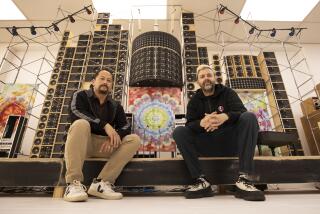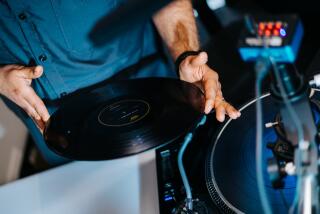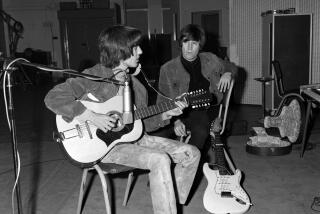Reinventing the machine that let America hear itself on the PBS-BBC doc ‘American Epic’

Recording engineer Nicholas Bergh has a working recording system from the 1920s made by Western Electric. The system allowed record labels to make field recordings.
It’s a tangential moment in the Emmy Award-nominated documentary “American Epic,” but one that grabs viewers’ attention.
Recording engineer Nicholas Bergh cranks the handle on a 90-year-old recording device — one he spent more than a decade on during a detective-like quest to painstakingly restore it to working condition. He’s preparing it for a modern-day studio session with bluesy rocker Jack White and several cohorts when an inch-wide band of fabric attached to a 100-pound weight that drives the contraption snaps.
The weight crashes to the floor, scotching the attempt, at least temporarily. White, however, grabs the broken fabric strip, hops in a car and races to the nearest tailor shop he can find to the Melrose Avenue studio. There, he commandeers a sewing machine and stitches it back together on the spot.
Problem solved. Crisis averted.
See the most-read stories in Entertainment this hour »
This ingenuity, resourcefulness and creative engineering exemplify a key theme of “American Epic,” the ambitious four-part BBC-PBS collaboration that reveals how technological and cultural changes intersected in the mid-1920s to revolutionize the nascent recording industry.
An indispensable part of the story is the record-cutting lathe and its companion electric amplification system that Bergh, 40, pieced together to re-create and better understand the way music was recorded in far-flung regions around the country.
It was this musical venture that allowed Americans, as narrator and project co-executive producer Robert Redford says in the film, “to hear themselves for the first time.”
Filmmakers Bernard MacMahon and Allison McGourty highlight the unforeseen ripple effects of commercial record companies’ attempts to survive the rise of radio in the mid-’20s, when suddenly consumers could enjoy music without having to pay for records.
Those companies sent teams of talent scouts out into the hinterlands to record regional styles of music, hoping to make up plummeting record sales by marketing to audiences they had largely ignored and which were not being served by radio stations either.
“If the first three ‘American Epic’ films are like the story of the Apollo [first manned moon landing] mission, with unseen film footage, interviews with the astronauts and scientists, then the fourth film, ‘The American Epic Sessions,’ is where we rebuild the rocket and go to the moon ourselves,” co-producer and co-writer McGourty said.
One revelation in assembling “American Epic” was the evidence of just how good the early recording equipment was — and still is today.
Bergh, an ethnomusicology student at UCLA from 1998 to 2002, was fascinated with the means by which early recordings he was studying were created. “I just wanted to look at a picture of the machine. I tried to Google it and found nothing. None of the books in the libraries I researched had any photos either.”
A quest was born.
Bergh eventually found “one very old, grainy picture” showing an old Scully cutting lathe — so named for its creator John J. Scully — and a Western Electric amplification system that had been used for recordings made during the talent scouting sessions. He soon discovered that the company kept technical information about that equipment highly classified, fearing others might steal their proprietary technology.
Bits and pieces of the mid-’20s Scully lathe, and the companion amplification equipment that facilitated the shift from acoustical to electrical recording, still existed, but Bergh learned that a fully intact version did not.
So he set about reconstructing it.
“It was like putting together a 10,000-piece jigsaw puzzle — without the picture on the box to guide you,” “American Epic” director Bernard MacMahon told The Times recently.
Bergh tracked down various parts he needed in places as far away as Japan and Europe, and spent more than 10 years bringing it back to working order. “Probably more like 15 in all,” he said recently in his EndPoint Audio Lab facility in Burbank, where the unit resides.
For instance, to acquire one part for the Western Electric portion of the rig, Bergh traced the rare microphone pre-amp section to a collector in Tokyo and worked out a three-way trade involving three 1940s vintage recording amplifiers and a second collector.
“Along with my research and sound engineering background,” he added, “I also had a background restoring antique cars, which was very helpful in this sort of dirty hands-on research. Rarely does historical research result in the sort of cut-up hands and 450-volt shocks that this research often led to.”
Bergh pointed out that the cutting head on the machine — the component that actually carved grooves into the discs, allowing music to be played back — was technologically so good that it remained in common use until the late 1940s.
It was only with the development of microgroove technology after World War II that a new generation of cutting head came into use.
The Scully lathe itself is a marvel of early 20th century engineering. It’s almost entirely mechanical, driven by the previously referenced 100-pound weight. That weight, the largest of three the lathe uses, descends gradually along a four-foot drop, its descent controlled by a governor assembly and a seven-gear transmission that can vary the groove spacing while a single live performance is cut onto a 10-inch black lacquer master disc.
The weight is connected by pulleys to the turntable, which revolves beneath the stationary cutting head. Because the head doesn’t move, the turntable carriage also has to move laterally beneath that cutting head as it etches a groove from the outside perimeter of the disc toward the center.
The lathe requires limited electricity, which is needed for an electromagnet that operates the cutting head, as well as to power a strobe that allows the engineer to monitor the turntable’s speed. Energy is also required for a vacuum that whisks away threads of lacquer as the cutting head does its work.
The nominal reliance on electricity was necessary, as this was before recording teams could depend on reliable AC electrical outlets in remote locations. Many lugged along racks of batteries to power the equipment.
The lathe predates the switch from acoustic to electric recording. During the acoustic era from the late 1800s until the mid-1920s, such lathes were connected to large horn sound collectors — early microphones — that required musicians to sing and play at maximum volume to create enough energy to physically move the sound horn diaphragm and the attached cutting head.
To experience the recording process, this reporter brought his clarinet to Bergh’s lab and played “Petite Fleur,” an old New Orleans jazz standard associated with Sidney Bechet. Played back through a massive vintage movie theater loudspeaker, the recording sounded stunningly true-to-life.
The reason vintage 78 rpm records typically sound so primitive compared with modern recordings traces to the weak link in the original record-playback chain: Blame the steel needles used on old gramophone players, which literally began decimating records from the first time they were played.
The same recording-playback system also provided the foundation of the revolution the film industry underwent in the late ’20s: talkies.
Today, Bergh spends most of his time working on restorations of vintage film soundtracks. But he said the Scully lathe theoretically could still be used by contemporary musicians to make high-quality recordings for release on vinyl.
“This machine was like the first mirror,” McGourty said. “It gave the world the opportunity to record every kind of voice and instrumentation, and to faithfully reproduce those performances on a phonograph record.
“For the first time, this technology allowed everybody to be recorded,” she said, “and it democratized American music.”
Follow @RandyLewis2 on Twitter.com
For Classic Rock coverage, join us on Facebook
More to Read
The biggest entertainment stories
Get our big stories about Hollywood, film, television, music, arts, culture and more right in your inbox as soon as they publish.
You may occasionally receive promotional content from the Los Angeles Times.










